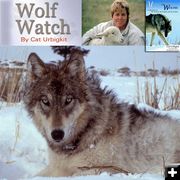Predators alter cattle behavior
by Cat Urbigkit, Pinedale Online!
May 11, 2009
A new paper in the journal Behavioural Processes examines cattle response to predator stimuli. With the research conducted by B. Kluever, L. Howery, S. Breck, and D. Bergman, here's the abstract to the paper:
"Wild and domestic ungulates modify their behaviour in the presence of olfactory and visual cues of predators but investigations have not exposed a domestic species to a series of cues representing various predators and other ungulate herbivores.
"We used wolf (Canis lupus), mountain lion (Puma concolor), and mule deer (Odocoileus hemionus) stimuli (olfactory and visual), and a control (no stimuli) to experimentally test for differences in behaviour of cattle (Bos taurus) raised in Arizona.
"We measured (1) vigilance, (2) foraging rates, (3) giving up density (GUD) of high quality foods and (4) time spent in high quality forage locations in response to location of stimuli treatments.
"In general, we found a consistent pattern in that wolf and deer treatments caused disparate results in all 4 response variables. Wolf stimuli significantly increased cattle vigilance and decreased cattle foraging rates; conversely, deer stimuli significantly increased cattle foraging rate and increased cattle use of high quality forage areas containing stimuli. Mountain lion stimuli did not significantly impact any of the 4 response variables.
"Our findings suggest that domestic herbivores react to predatory stimuli, can differentiate between stimuli representing two predatory species, and suggest that cattle may reduce antipredatory behaviour when near heterospecifics."
Citation:
Kluever, B.; Howery, L.; Breck, S.; Bergman, D.
Predator and heterospecific stimuli alter behaviour in cattle2009, Behavioural Processes 81: 85-91
|
